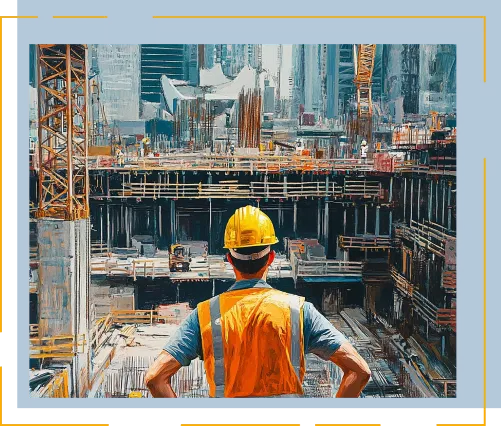Now Offering Spanish Safety Training!

Now Offering Spanish Safety Training!
Construction Safety
On-Site Inspections
FSDAVCFEBFEVSDDVFSD
FSDAVCFEBFEVSDDVFSD
FSDAVCFEBFEVSDDVFSD
Construction Safety - On-Site Inspections
Construction Site Safety Inspections for OSHA Compliance

On-site safety inspections help maintain compliance at construction sites by identifying hazards like unsafe equipment use or improper scaffolding. These inspections ensure adherence to OSHA guidelines, which fosters a safer work environment. Proactive inspection methods reduce the risk of accidents and enhance overall safety measures across the site.
Regular assessments cover various safety components, including equipment handling, emergency response readiness, and structural integrity. By conducting detailed inspections, safety protocols remain current and effective, reducing the likelihood of non-compliance. Frequent evaluations help adapt to site-specific risks, improving the safety culture among workers.

Identifying and Correcting Safety Hazards On Site
Effective on-site inspections aim to identify potential risks early, such as unstable scaffolding, improper equipment usage, or inadequate fall protection measures. Inspectors conduct thorough evaluations to ensure compliance with OSHA standards, which significantly reduces the likelihood of on-site incidents and creates safer working conditions.
Regular site assessments also involve reviewing safety protocols to verify they are current and consistently followed by workers. This process ensures that safety measures are not only understood but also practiced daily. Inspectors encourage open communication during evaluations, allowing workers to share safety concerns or suggest updates. This feedback helps tailor protocols to specific site conditions, enhancing practical safety measures.
In addition to identifying hazards, inspections focus on prompt corrective actions. For example, organizing for safety equips teams to resolve issues quickly, ensuring compliance is maintained. Swift adjustments not only minimize immediate risks but also reinforce a proactive safety culture, keeping standards aligned with regulatory requirements and fostering a safer construction site.
Promoting Complete Safety with Thorough Inspections

On-site inspections not only identify hazards but also enhance workers' safety awareness. Inspectors assess safety procedures to ensure they align with job-specific tasks, helping employees understand and apply safety measures correctly. Training sessions conducted during inspections refine workers' skills, improving their ability to operate equipment safely and confidently. This proactive approach reduces risks and fosters a lasting safety culture, encouraging consistent compliance across all projects.
Thorough documentation is a key component of successful inspections. Inspectors carefully record observations, corrective actions, and compliance updates, providing references for future evaluations. This documentation helps identify recurring safety challenges, allowing managers to address them strategically. By analyzing these records, teams can develop targeted solutions that sustain compliance while minimizing site hazards. This ensures that immediate safety gaps are closed while preventing future risks, supporting a safer, more organized construction environment.

Routine follow-up inspections play a crucial role in reinforcing safety measures, ensuring that corrective actions are fully implemented and effective. Inspectors review the adjustments made after initial inspections, confirming compliance with updated safety protocols. This evaluation process not only verifies adherence to standards but also assesses the effectiveness of training programs, promoting a consistent application of safety practices across different projects.
Regular worker feedback is also essential for improving safety measures. Open discussions provide employees with a platform to voice concerns, share experiences, and suggest updates to current safety protocols. This collaborative approach fosters a culture of shared responsibility, where workers feel valued and involved in the safety process. By actively participating, employees contribute to refining protocols, reducing risks, and enhancing compliance across construction sites. This emphasis on communication and feedback supports ongoing safety improvements, leading to a safer and more organized work environment.
Frequently Asked Questions
Frequently Asked Questions
How often should we schedule on-site safety inspections for our construction projects?
Regular on-site safety inspections are recommended to be conducted at various stages of a construction project, not just at the beginning or end. The frequency can vary based on the project's scope, duration, and complexity, but a monthly or quarterly inspection is typically beneficial to proactively identify and mitigate potential hazards.
What specific areas do the on-site inspections cover in a construction environment?
On-site inspections focus on a comprehensive range of areas including, but not limited to, fall protection systems, scaffolding, electrical safety, personal protective equipment, fire prevention, and hazard communication. Inspections are tailored to the specific operations and risks associated with each construction site.
Can Nain and Associates provide recommendations for corrective actions following an on-site inspection?
Yes, following each on-site inspection, Nain and Associates provides a detailed report outlining any identified safety hazards along with practical recommendations for corrective actions. Our goal is to help construction businesses not only address immediate safety concerns but also improve their overall safety management practices.
How do on-site safety inspections contribute to compliance with OSHA regulations?
By identifying potential safety hazards and ensuring that safety protocols are being correctly implemented, on-site inspections play a crucial role in maintaining compliance with OSHA regulations. They help to prevent violations by ensuring that construction sites adhere to the latest safety standards and best practices.
What happens if a significant safety issue is discovered during an inspection?
If a significant safety issue is discovered during an inspection, immediate action is recommended to mitigate the risk to workers. Nain and Associates will assist in prioritizing the issue, recommending effective solutions, and providing guidance on implementing these measures to ensure the safety of all personnel and compliance with regulatory standards.
Consistent Safety Standards Create a Thriving Job Site
Routine inspections ensure that safety protocols remain consistent and effective across all projects. Inspectors conduct detailed evaluations, verifying that safety documentation is not only in place but also properly implemented by the workers. This approach emphasizes adherence to protocols, reducing potential hazards and promoting a safer work environment.
In addition to identifying immediate risks, inspections help anticipate potential challenges. By assessing site-specific conditions, inspectors can recommend proactive measures that address emerging risks before they become issues. This proactive strategy fosters a culture of vigilance and readiness, enhancing overall safety management.
Regular safety updates are crucial for keeping workers informed of new regulations and procedures. Providing employees with ongoing training and clear communication ensures they stay prepared for changing conditions. Consistent updates to safety standards and policies help maintain compliance, reinforcing workers’ commitment to safe practices.


Regular evaluation of training programs and safety procedures is essential for long-term success. Continuous feedback from workers enables timely adjustments, keeping protocols practical and relevant to real-world conditions. Actively involving employees in these assessments fosters a sense of responsibility and ownership, strengthening the overall culture of safety across the site.
Remain OSHA Compliant for Years to Come
Achieving long-term safety compliance requires more than just periodic inspections—it involves fostering an ongoing culture of safety awareness. This process starts with consistent training that aligns with evolving OSHA regulations and site-specific needs. Training should emphasize not only technical skills but also the importance of staying vigilant and proactive about potential hazards. Workers who understand the broader safety objectives are more likely to actively participate, helping to maintain compliance across projects.
Proactive communication is another key element in sustaining safety measures. Regular safety meetings allow for open discussions about protocols, updates, and site-specific concerns. These sessions encourage workers to voice their experiences, helping to identify gaps in current procedures. Addressing these issues in real-time prevents small problems from becoming significant hazards, ensuring a safer work environment. Additionally, involving employees in decision-making fosters a sense of ownership and responsibility, further strengthening their commitment to safety.
Maintaining thorough documentation of inspections, corrective actions, and training sessions is crucial for tracking compliance over time. Detailed records help teams identify trends, measure the effectiveness of interventions, and adjust strategies as needed. By using these insights to drive continuous improvements, safety teams can develop targeted solutions that address persistent issues. This comprehensive approach not only reinforces compliance but also contributes to a proactive, safety-driven culture throughout the construction site, promoting overall success.
Have Questions About Our Services?
Contact us to learn more today!
Have Questions About Our Services?
Contact us to learn more today!
Design By: Customers.Plus
© 2025 | Nain & Associates LLC




